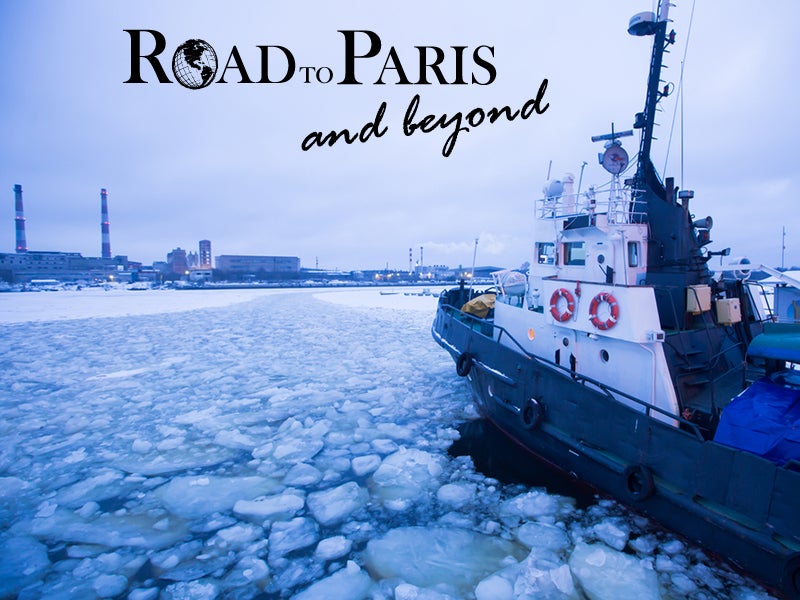Why We Should Keep It in the (Frozen, Arctic) Ground
In rejecting the Keystone XL pipeline, President Obama emphasized the need to “keep it in the ground” when it comes to fossil fuels. He should follow his own advice when it comes to Arctic drilling.

This page was published 10 years ago. Find the latest on Earthjustice’s work.
The Arctic has long been a bellwether of the consequences of climate change, with melting sea-ice, eroding coastlines and species like polar bears and walruses in peril as their habitat melts and changes. It has also been home to a cynical irony—as climate change melted the ice, oil companies rushed into the newly accessible waters in search of oil that would only worsen climate change and continue to hasten the region’s decline.
But remarkably, in the past six months, the tide appears to be turning:
- In early summer, exuberant and creative “kayaktivists” in Seattle, Portland and elsewhere shouted loud and clear that offshore drilling in the Arctic Ocean is terrible for the region and the climate, gaining national attention and inspiring even more people to act.
- In September, President Obama visited Alaska, becoming the first sitting president to travel above the Arctic Circle and drawing nationwide attention to the importance of addressing rapid climate change. While he was here, he had to field questions about the tension between his call for urgent action on climate and his administration’s decision to allow Shell Oil to drill in the Arctic Ocean last summer.
- Later that month, Shell Oil announced that after years of trying to drill in the Arctic Ocean, it would abandon its drilling plans in the region for the foreseeable future.
- In October, the president announced that he was cancelling future oil lease sales in the Arctic Ocean and also denying oil companies’ requests to extend the terms of the leases they currently hold there.
- And just last week, another oil company, Statoil, announced that it too was abandoning the Arctic, closing its offices in Alaska and heading home.
There is still work to do. Millions of acres of the Arctic Ocean remain under lease to oil companies, Shell has left the door open for future activities and other oil companies still lurk. We remain in court fighting to protect the Arctic Ocean from these and other threats. But the events of the past six months provide a great opportunity to turn the Arctic from a symbol of how we are losing the battle against climate change to the place where we start to win it.
And the moment could not be better.
Just a few weeks ago, with his rejection of the Keystone XL pipeline, the president took the first major step toward addressing the problem of excess fossil fuel production. Until then, his bold actions on climate change had focused on reducing carbon emissions from energy consumption by issuing rules for cleaner power plants and promoting energy efficient cars, for example.
The shift to addressing the supply side is critical—the international scientific community has concluded that we have already discovered 4 to 7 times the amount of fossil fuel we can safely burn to avoid the worst effects of climate change. As President Obama said when explaining the Keystone XL decision: “If we’re going to prevent large parts of this earth from becoming not only inhospitable, but uninhabitable in our lifetimes, we’re going to have to keep some fossil fuels in the ground, rather than burn them and release more dangerous pollution into the sky.”
The Arctic Ocean is the perfect—and obvious—place to keep fossil fuels in the ground. We cannot safely drill for oil there and we cannot safely burn any oil we find. Plus, the oil wouldn’t come to market for at least a decade, by which time we need to be well on our way to cleaner alternatives. The region is sensitive and irreplaceable. Oil operations there are risky, dirty and prone to accidents, as Shell’s efforts over the past few years have shown. The government has concluded there is a 75 percent chance of one or more major oil spills if oil were discovered and developed there. And all experts agree that there is no way effectively to contain and clean up a spill in the Arctic Ocean.
The upcoming global climate summit in Paris must send a strong signal to the markets that governments will reward innovation and investment in clean, renewable energy and clamp down on fossil fuels. The U.S. has put forward a strong emissions reduction pledge for Paris, anchored by the Clean Power Plan. But for the U.S. and the world, what matters as much as the new agreement is what happens afterward. Keeping Arctic oil in the ground would signal the U.S.’s commitment both to this stunningly beautiful and fragile region and to the world.
Decisions about the Arctic Ocean are the president’s to make. He has the authority to withdraw the region from all future oil leasing. As the president positions the United States to be a leader during the climate summit, we urge him to build on the important steps he has taken to date and exercise his authority to keep the Arctic Ocean off-limits to oil development.
The Road to Paris and Beyond is a blog series exploring how Earthjustice’s climate and energy work will help strengthen the goals to be set by the United States and others during the 2015 United Nations Climate Change Conference in Paris, and the development of the new global climate agreement. The Paris Climate Change Conference (aka “COP21”) begins on November 30 and runs until December 11, 2015.
Opened in 1978, our Alaska regional office works to safeguard public lands, waters, and wildlife from destructive oil and gas drilling, mining, and logging, and to protect the region's marine and coastal ecosystems.